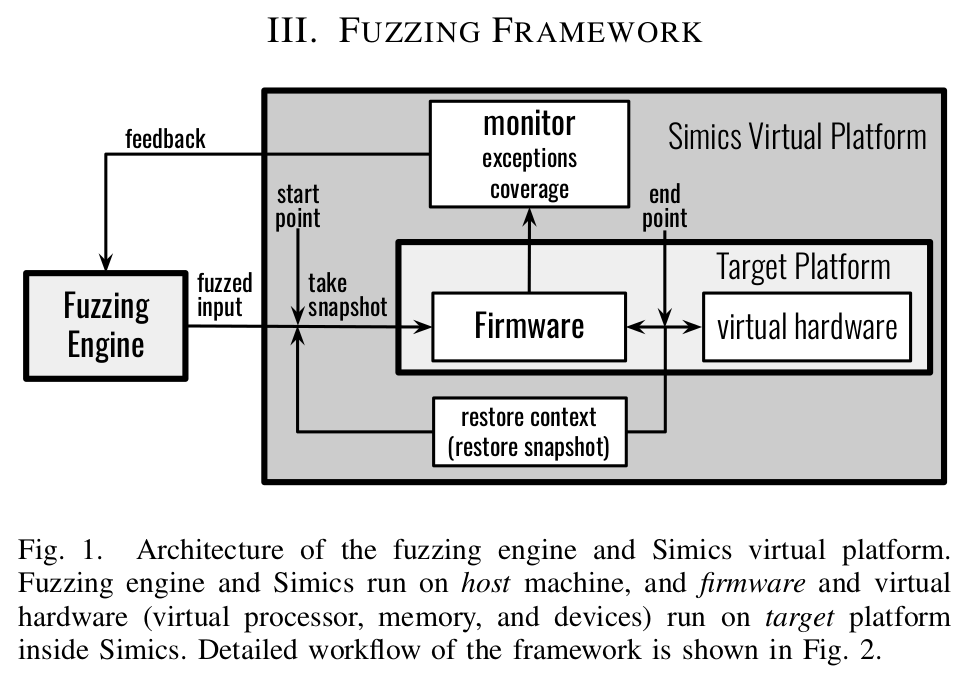Network and Distributed System Security Symposium (1)
Towards Automated Dynamic Analysis for Linux-based Embedded Firmware
Authors: Daming D. Chen, Maverick Woo, David Brumley, Manuel Egele
Year: 2016
Abstract:
Commercial-off-the-shelf (COTS) network-enabled embedded devices are usually controlled by vendor firmware to perform integral functions in our daily lives. For example, wireless home routers are often the first and only line of defense that separates a home user’s personal computing and information devices from the Internet. Such a vital and privileged position in the user’s network requires that these devices operate securely. Unfortunately, recent research and anecdotal evidence suggest that such security assumptions are not at all upheld by the devices deployed around the world.
A first step to assess the security of such embedded device firmware is the accurate identification of vulnerabilities. However, the market offers a large variety of these embedded devices, which severely impacts the scalability of existing approaches in this area. In this paper, we present FIRMADYNE, the first automated dynamic analysis system that specifically targets Linux-based firmware on network-connected COTS devices in a scalable manner. We identify a series of challenges inherent to the dynamic analysis of COTS firmware, and discuss how our design decisions address them. At its core, FIRMADYNE relies on software-based full system emulation with an instrumented kernel to achieve the scalability necessary to analyze thousands of firmware binaries automatically.
We evaluate FIRMADYNE on a real-world dataset of 23,035 firmware images across 42 device vendors gathered by our system. Using a sample of 74 exploits on the 9,486 firmware images that our system can successfully extract, we discover that 887 firmware images spanning at least 89 distinct products are vulnerable to one or more of the sampled exploit(s). This includes 14 previously-unknown vulnerabilities that were discovered with the aid of our framework, which affect 69 firmware images spanning at least 12 distinct products. Furthermore, our results show that 11 of our tested attacks affect firmware images from more than one vendor, suggesting that code-sharing and common upstream manufacturers (OEMs) are quite prevalent.
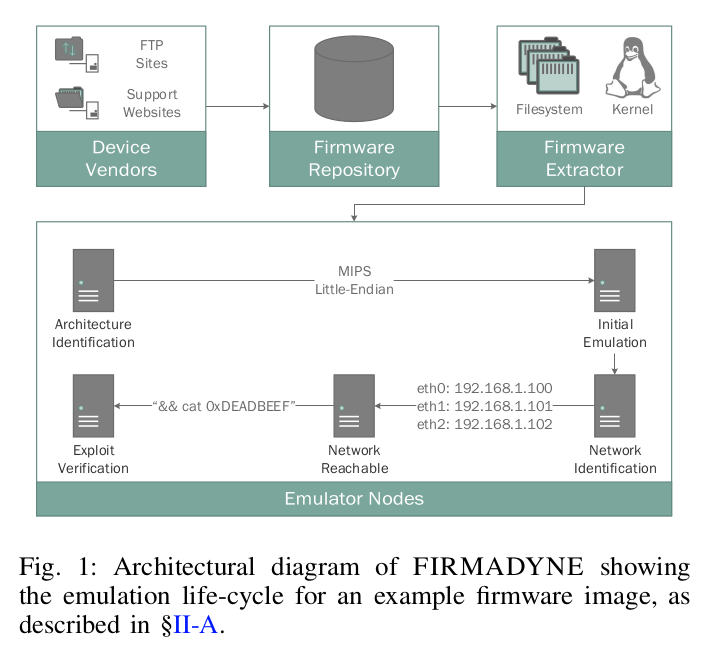
Annual Computer Security Applications Conference (1)
FirmAE: Towards Large-Scale Emulation of IoT Firmware for Dynamic Analysis
Authors: Mingeun Kim, Dongkwan Kim, Eunsoo Kim, Suryeon Kim, Yeongjin Jang, Yongdae Kim
Year: 2020
Abstract:
One approach to assess the security of embedded IoT devices is applying dynamic analysis such as fuzz testing to their firmware in scale. To this end, existing approaches aim to provide an emulation environment that mimics the behavior of real hardware/peripherals. Nonetheless, in practice, such approaches can emulate only a small fraction of firmware images. For example, Firmadyne, a state-of-the-art tool, can only run 183 (16.28%) of 1,124 wireless router/IP-camera images that we collected from the top eight manufacturers. Such a low emulation success rate is caused by discrepancy in the real and emulated firmware execution environment.
In this study, we analyzed the emulation failure cases in a large-scale dataset to figure out the causes of the low emulation rate. We found that widespread failure cases often avoided by simple heuristics despite having different root causes, significantly increasing the emulation success rate. Based on these findings, we propose a technique, arbitrated emulation, and we systematize several heuristics as arbitration techniques to address these failures. Our automated prototype, FirmAE, successfully ran 892 (79.36%) of 1,124 firmware images, including web servers, which is significantly (≈ 4.8x) more images than that run by Firmadyne. Finally, by applying dynamic testing techniques on the emulated images, FirmAE could check 320 known vulnerabilities (306 more than Firmadyne), and also find 12 new 0-days in 23 devices.

Usenix Security Symposium (9)
Fuzzware: Using Precise MMIO Modeling for Effective Firmware Fuzzing
Authors: Tobias Scharnowski, Nils Bars, Moritz Schloegel, Eric Gustafson, Marius Muench, Giovanni Vigna, Christopher Kruegel, Thorsten Holz, Ali Abbasi
Year: 2022
Abstract:
As embedded devices are becoming more pervasive in our everyday lives, they turn into an attractive target for adversaries. Despite their high value and large attack surface, applying automated testing techniques such as fuzzing is not straightforward for such devices. As fuzz testing firmware on constrained embedded devices is inefficient, state-of-the-art approaches instead opt to run the firmware in an emulator (through a process called re-hosting). However, existing approaches either use coarse-grained static models of hardware behavior or require manual effort to re-host the firmware.
We propose a novel combination of lightweight program analysis, re-hosting, and fuzz testing to tackle these challenges. We present the design and implementation of Fuzzware, a software-only system to fuzz test unmodified monolithic firmware in a scalable way. By determining how hardware-generated values are actually used by the firmware logic, Fuzzware can automatically generate models that help focusing the fuzzing process on mutating the inputs that matter, which drastically improves its effectiveness.
We evaluate our approach on synthetic and real-world targets comprising a total of 19 hardware platforms and 77 firmware images. Compared to state-of-the-art work, Fuzzware achieves up to 3.25 times the code coverage and our modeling approach reduces the size of the input space by up to 95.5%. The synthetic samples contain 66 unit tests for various hardware interactions, and we find that our approach is the first generic re-hosting solution to automatically pass all of them. Fuzzware discovered 15 completely new bugs including bugs in targets which were previously analyzed by other works; a total of 12 CVEs were assigned.
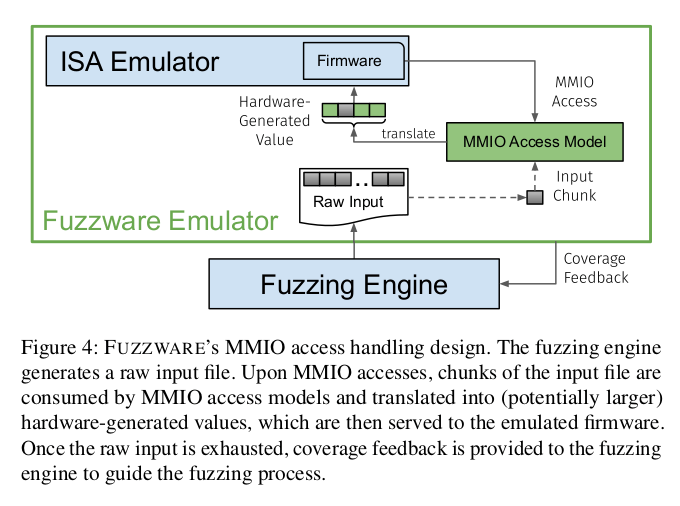
RapidPatch: Firmware Hotpatching for Real-Time Embedded Devices
Authors: Yi He, Zhenhua Zou, Kun Sun, Zhuotao Liu, Ke Xu, Qian Wang, Chao Shen, Zhi Wang, Qi Li
Year: 2022
Abstract:
Nowadays real-time embedded devices are becoming one main target of cyber attacks. A huge number of embedded devices equipped with outdated firmware are subject to various vulnerabilities, but they cannot be timely patched due to two main reasons. First, it is difficult for vendors who have various types of fragmented devices to generate patches for each type of device. Second, it is challenging to deploy patches on many embedded devices without restarting or halting real-time tasks, hindering the patch installation on devices (e.g., industrial control devices) that have high availability requirements. In this paper, we present RapidPatch, a new hotpatching framework to facilitate patch propagation by installing generic patches without disrupting other tasks running on heterogeneous embedded devices. RapidPatch allows RTOS developers to directly release common patches for all downstream devices so that device maintainers can easily generate device-specific patches for different firmware. We utilize eBPF virtual machines to execute patches on resource-constrained embedded devices and develop three hotpatching strategies to support hotpatching for all major microcontroller (MCU) architectures. In particular, we propose two types of eBPF patches for different types of vulnerabilities and develop an eBPF patch verifier to ensure patch safety. We evaluate RapidPatch with major CVEs on four major RTOSes running on different embedded devices. We find that over 90% vulnerabilities can be hotpatched via RapidPatch. Our system can work on devices with 64 KB or more memory and 64 MHz MCU frequency. The average patch delay is less than 8 µs and the overall latency overhead is less than 0.6%.

Jetset: Targeted Firmware Rehosting for Embedded Systems
Authors: Evan Johnson, Maxwell Bland, Yifei Zhu, Joshua Mason, Stephen Checkoway, Stefan Savage, Kirill Levchenko
Year: 2021
Abstract:
The ability to execute code in an emulator is a fundamental part of modern vulnerability testing. Unfortunately, this poses a challenge for many embedded systems, where firmware expects to interact with hardware devices specific to the target. Getting embedded system firmware to run outside its native environment, termed rehosting, requires emulating these hardware devices with enough accuracy to convince the firmware that it is executing on the target hardware. However, full fidelity emulation of target devices (which requires considerable engineering effort) may not be necessary to boot the firmware to a point of interest for an analyst (for example, a point where fuzzer input can be injected). We hypothesized that, for the firmware to boot successfully, it is sufficient to emulate only the behavior expected by the firmware, and that this behavior could be inferred automatically.
To test this hypothesis, we developed and implemented Jetset, a system that uses symbolic execution to infer what behavior firmware expects from a target device. Jetset can generate devices models for hardware peripherals in C, allowing an analyst to boot the firmware in an emulator (e.g., QEMU). We successfully applied Jetset to thirteen distinct pieces of firmware together representing three architectures, three application domains (power grid, avionics, and consumer electronics), and five different operating systems. We also demonstrate how Jetset-assisted rehosting facilitates fuzz-testing, a common security analysis technique, on an avionics embedded system, in which we found a previously unknown privilege escalation vulnerability.
Automatic Firmware Emulation through Invalidity-guided Knowledge Inference
Authors: Wei Zhou, Le Guan, Peng Liu, Yuqing Zhang
Year: 2021
Abstract:
Emulating firmware for microcontrollers is challenging due to the tight coupling between the hardware and firmware. This has greatly impeded the application of dynamic analysis tools to firmware analysis. The state-of-the-art work automatically models unknown peripherals by observing their access patterns, and then leverages heuristics to calculate the appropriate responses when unknown peripheral registers are accessed. However, we empirically found that this approach and the corresponding heuristics are frequently insufficient to emulate firmware. In this work, we propose a new approach called µEmu to emulate firmware with unknown peripherals. Unlike existing work that attempts to build a general model for each peripheral, our approach learns how to correctly emulate firmware execution at individual peripheral access points. It takes the image as input and symbolically executes it by representing unknown peripheral registers as symbols. During symbolic execution, it infers the rules to respond to unknown peripheral accesses. These rules are stored in a knowledge base, which is referred to during the dynamic firmware analysis. µEmu achieved a passing rate of 93% in a set of unit tests for peripheral drivers without any manual assistance. We also evaluated µEmu with real-world firmware samples and new bugs were discovered.
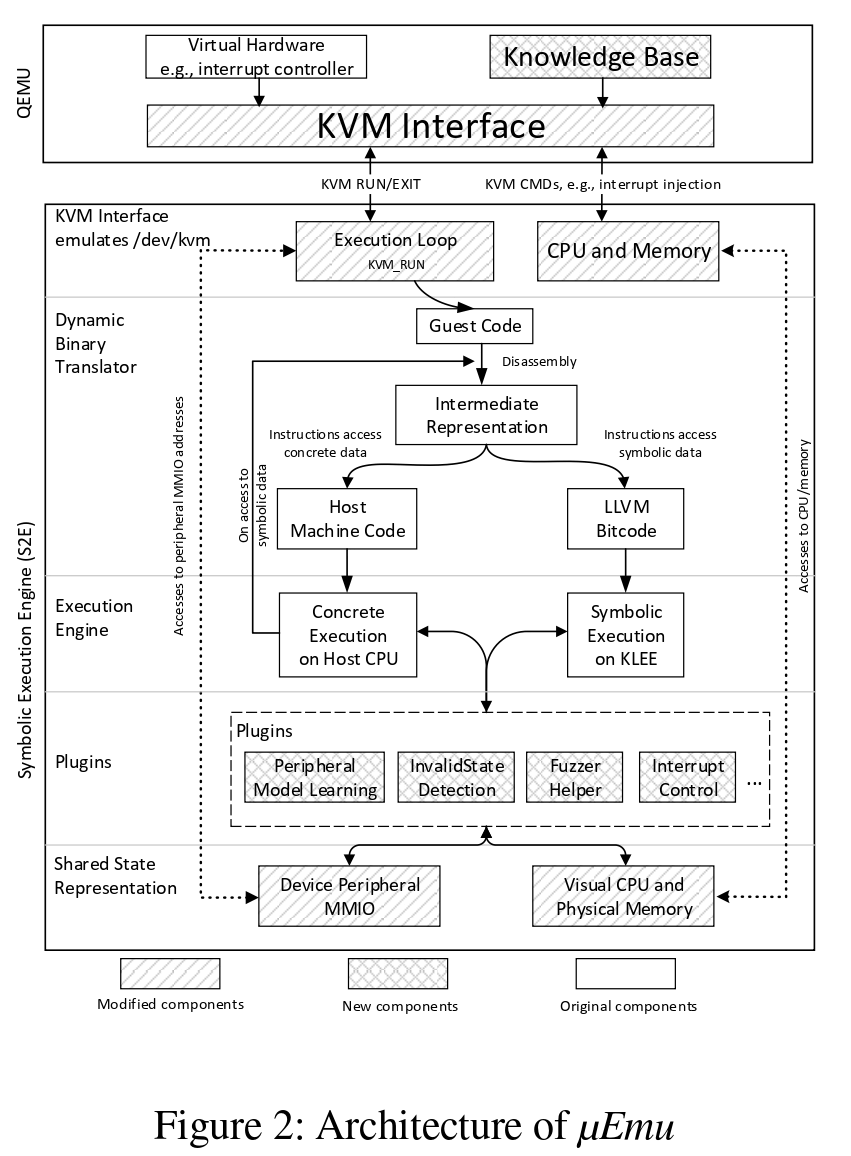
The Circle Of Life: A Large-Scale Study of The IoT Malware Lifecycle
Authors: Omar Alrawi, Charles Lever, Kevin Valakuzhy, Ryan Court, Kevin Z. Snow, Fabian Monrose, Manos Antonakakis
Year: 2021
Abstract:
Our current defenses against IoT malware may not be adequate to remediate an IoT malware attack similar to the Mirai botnet. This work seeks to investigate this matter by systematically and empirically studying the lifecycle of IoT malware and comparing it with traditional malware that target desktop and mobile platforms. We present a large-scale measurement of more than 166K Linux-based IoT malware samples collected over a year. We compare our results with prior works by systematizing desktop and mobile malware studies into a novel framework and answering key questions about defense readiness. Based on our findings, we deduce that the required technology to defend against IoT malware is available, but we conclude that there are insufficient efforts in place to deal with a large-scale IoT malware infection breakout.
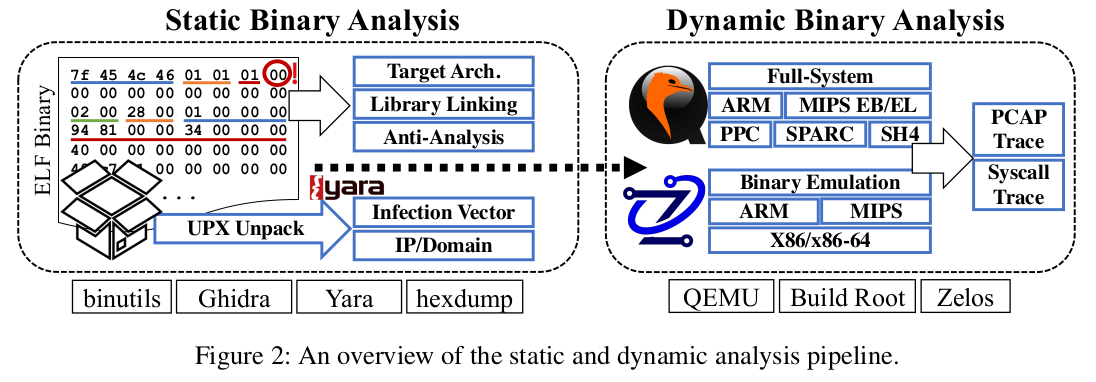
Sharing More and Checking Less: Leveraging Common Input Keywords to Detect Bugs in Embedded Systems
Authors: Libo Chen, Yanhao Wang, Quanpu Cai, Yunfan Zhan, Hong Hu, Jiaqi Linghu, Qinsheng Hou, Chao Zhang, Haixin Duan, Zhi Xue
Year: 2021
Abstract:
IoT devices have brought invaluable convenience to our daily life. However, their pervasiveness also amplifies the impact of security vulnerabilities. Many popular vulnerabilities of embedded systems reside in their vulnerable web services. Unfortunately, existing vulnerability detection methods cannot effectively nor efficiently analyze such web services: they either introduce heavy execution overheads or have many false positives and false negatives.
In this paper, we propose a novel static taint checking solution, SaTC, to effectively detect security vulnerabilities in web services provided by embedded devices. Our key insight is that, string literals on web interfaces are commonly shared between front-end files and back-end binaries to encode user input. We thus extract such common keywords from the front-end, and use them to locate reference points in the back-end, which indicate the input entry. Then, we apply targeted data-flow analysis to accurately detect dangerous uses of the untrusted user input. We implemented a prototype of SaTC and evaluated it on 39 embedded system firmwares from six popular vendors. SaTC discovered 33 unknown bugs, of which 30 are confirmed by CVE/CNVD/PSV. Compared to the state-of-the-art tool KARONTE, SaTC found significantly more bugs on the test set. It shows that, SaTC is effective in discovering bugs in embedded systems.
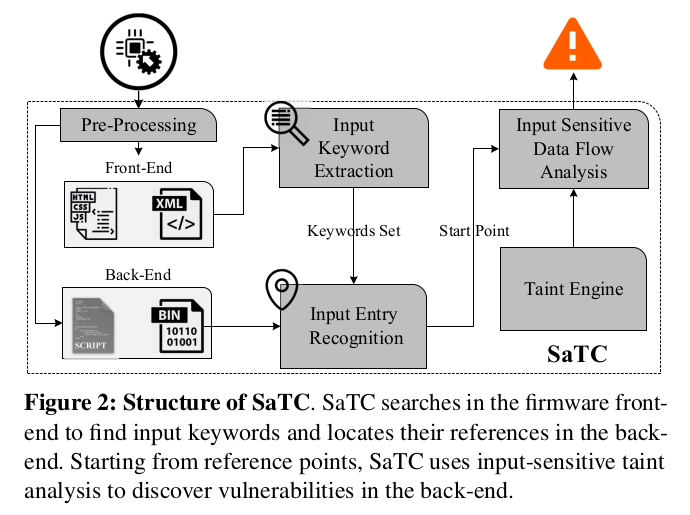
HALucinator: Firmware Re-hosting Through Abstraction Layer Emulation
Authors: Abraham A. Clements, Eric Gustafson, Tobias Scharnowski, Paul Grosen, David Fritz, Christopher Kruegel, Giovanni Vigna, Saurabh Bagchi, Mathias Payer
Year: 2020
Abstract:
Given the increasing ubiquity of online embedded devices, analyzing their firmware is important to security, privacy, and safety. The tight coupling between hardware and firmware and the diversity found in embedded systems makes it hard to perform dynamic analysis on firmware. However, firmware developers regularly develop code using abstractions, such as Hardware Abstraction Layers (HALs), to simplify their job. We leverage such abstractions as the basis for the re-hosting and analysis of firmware. By providing high-level replacements for HAL functions (a process termed High-Level Emulation – HLE), we decouple the hardware from the firmware. This approach works by first locating the library functions in a firmware sample, through binary analysis, and then providing generic implementations of these functions in a full-system emulator.
We present these ideas in a prototype system, HALucinator, able to re-host firmware, and allow the virtual device to be used normally. First, we introduce extensions to existing library matching techniques that are needed to identify library functions in binary firmware, to reduce collisions, and for inferring additional function names. Next, we demonstrate the re-hosting process, through the use of simplified handlers and peripheral models, which make the process fast, flexible, and portable between firmware samples and chip vendors. Finally, we demonstrate the practicality of HLE for security analysis, by supplementing HALucinator with the American Fuzzy Lop fuzzer, to locate multiple previously-unknown vulnerabilities in firmware middleware libraries.

P2IM: Scalable and Hardware-independent Firmware Testing via Automatic Peripheral Interface Modeling
Authors: Bo Feng, Alejandro Mera, Long Lu
Year: 2020
Abstract:
Dynamic testing or fuzzing of embedded firmware is severely limited by hardware-dependence and poor scalability, partly contributing to the widespread vulnerable IoT devices. We propose a software framework that continuously executes a given firmware binary while channeling inputs from an off-the-shelf fuzzer, enabling hardware-independent and scalable firmware testing. Our framework, using a novel technique called P2IM, abstracts diverse peripherals and handles firmware I/O on the fly based on automatically generated models. P2IM is oblivious to peripheral designs and generic to firmware implementations, and therefore, applicable to a wide range of embedded devices. We evaluated our framework using 70 sample firmware and 10 firmware from real devices, including a drone, a robot, and a PLC. It successfully executed 79% of the sample firmware without any manual assistance. We also performed a limited fuzzing test on the real firmware, which unveiled 7 unique unknown bugs.
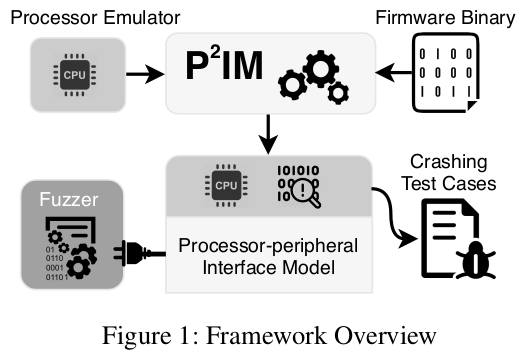
FIRM-AFL: High-Throughput Greybox Fuzzing of IoT Firmware via Augmented Process Emulation
Authors: Yaowen Zheng, Ali Davanian, Heng Yin, Chengyu Song, Hongsong Zhu, Limin Sun
Year: 2019
Abstract:
Cyber attacks against IoT devices are a severe threat. These attacks exploit software vulnerabilities in IoT firmware. Fuzzing is an effective software testing technique for finding these vulnerabilities so they can be patched. In this work, we present FIRM-AFL, the first high-throughput greybox fuzzer for IoT firmware. FIRM-AFL addresses two fundamental problems in IoT fuzzing. First, it addresses compatibility issues by enabling fuzzing for POSIX-compatible firmware that can be emulated in a system emulator. Second, it addresses the performance bottleneck caused by system-mode emulation with a novel technique called augmented process emulation. By integrating system-mode emulation and usermode emulation, augmented process emulation provides high compatibility as system-mode emulation and high throughput as user-mode emulation. Our evaluation results show that (1)FIRM-AFL is fully functional and capable of finding real world vulnerabilities in IoT programs and (2) the throughput of FIRM-AFL is on average 10 times higher than system-mode emulation based fuzzing; and (3) FIRM-AFL is able to find 1-day vulnerabilities much faster than system-mode emulation based fuzzing, and is able to find 0-day vulnerabilities.
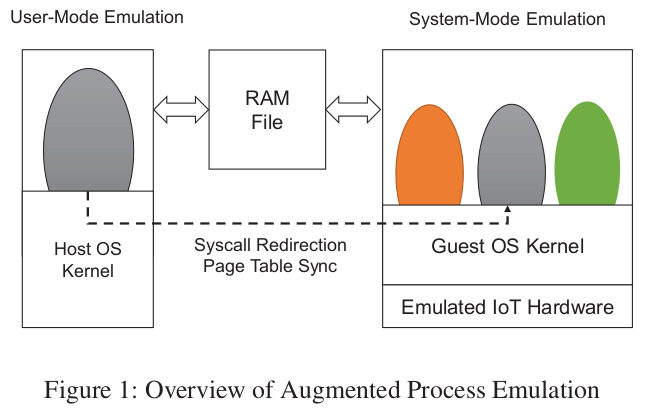
IEEE Symposium on Security and Privacy (6)
HEAPSTER: Analyzing the Security of Dynamic Allocators for Monolithic Firmware Images
Authors: Fabio Gritti, Fabio Pagani, Ilya Grishchenko, Lukas Dresel, Nilo Redini, Christopher Kruegel, Giovanni Vigna
Year: 2022
Abstract:
Dynamic memory allocators are critical components of modern systems, and developers strive to find a balance between their performance and their security. Unfortunately, vulnerable allocators are routinely abused as building blocks in complex exploitation chains. Most of the research regarding memory allocators focuses on popular and standardized heap libraries, generally used by high-end devices such as desktop systems and servers. However, dynamic memory allocators are also extensively used in embedded systems but they have not received much scrutiny from the security community.
In embedded systems, a raw firmware image is often the only available piece of information, and finding heap vulnerabilities is a manual and tedious process. First of all, recognizing a memory allocator library among thousands of stripped firmware functions can quickly become a daunting task. Moreover, emulating firmware functions to test for heap vulnerabilities comes with its own set of challenges, related, but not limited, to the re-hosting problem.
To fill this gap, in this paper we present HEAPSTER, a system that automatically identifies the heap library used by a monolithic firmware image, and tests its security with symbolic execution and bounded model checking. We evaluate HEAPSTER on a dataset of 20 synthetic monolithic firmware images — used as ground truth for our analyses — and also on a dataset of 799 monolithic firmware images collected in the wild and used in real-world devices. Across these datasets, our tool identified 11 different heap management library (HML) families containing a total of 48 different variations. The security testing performed by HEAPSTER found that all the identified variants are vulnerable to at least one critical heap vulnerability. The results presented in this paper show a clear pattern of poor security standards, and raise some concerns over the security of dynamic memory allocators employed by IoT devices.

-
Authors: Jiawei Yin, Menghao Li, Wei Wu, Dandan Sun, Jianhua Zhou, Wei Huo, Jingling Xue
Year: 2022
Abstract:
The Unified Extensible Firmware Interface (UEFI) provides a specification of the software interface between an OS and its underlying platform firmware. The runtime services provided are seemingly secure as they reside in System Management Mode (SMM) at ring -2, assuming a higher privilege than the OS kernel at ring 0. However, their software vulnerabilities are known to be exploitable to launch ring 0 to ring -2 privilege escalation, i.e., SMM privilege escalation attacks.
In this paper, we introduce an effective static analysis framework for detecting SMM privilege escalation vulnerabilities in UEFI firmware. We present a systematic study of such vulnerabilities and identify their root causes as being two types of references that can escape from the SMRAM, legacy references and unintentional references. Existing static analyses are ineffective in detecting such vulnerabilities in stripped COTS UEFI firmware images, which are developed based on a customized callback mechanism that organizes callable functions into protocols identified by GUIDs. By leveraging such a callback-based programming paradigm, we introduce SPENDER, the first static detection framework, which is founded on a novel protocol-centric analysis, for uncovering the potential SMM privilege escalation vulnerabilities in UEFI firmware efficiently and precisely. For a total of 1148 UEFI binaries collected from eight vendors, SPENDER has successfully found 36 SMM privilege escalation vulnerabilities (two 1-day and 34 0-day vulnerabilities), which can cause arbitrary code execution and arbitrary address write (and can thus enable, e.g., the attackers to install a bootkit into a flash drive). We have reported these 36 vulnerabilities to the vendors, with the two 1-day vulnerabilities confirmed as known previously but the 34 0-day vulnerabilities confirmed as new.
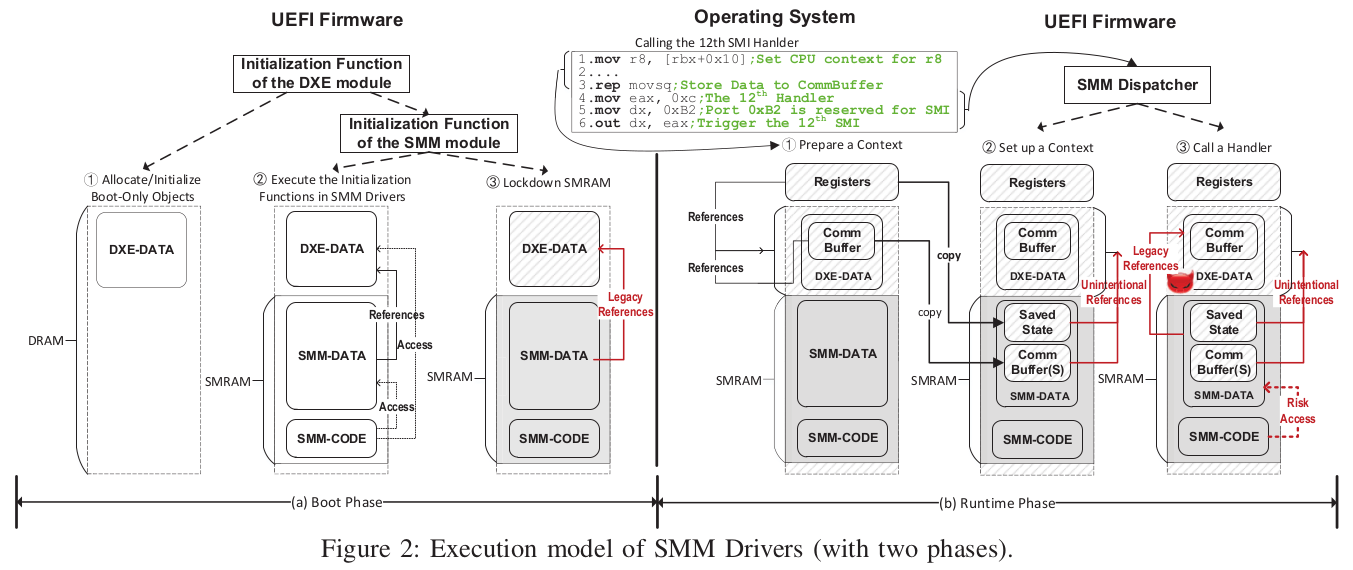
IRQDebloat: Reducing Driver Attack Surface in Embedded Devices
Authors: Zhenghao Hu, Brendan Dolan-Gavitt
Year: 2022
Abstract:
Embedded and IoT devices often come with a wide range of hardware functionality, but any particular end user may only use some small subset of these features. However, even unused hardware features are accompanied by potentially buggy driver code, which increases the attack surface of the device. In this paper, we introduce IRQDebloat, a system for disabling unwanted hardware features through automated firmware rewriting. Building on the insight that external inputs to the system are typically delivered through interrupt requests (IRQs), IRQDebloat systematically explores the interrupt handling code in the target firmware, identifies the handler function for each peripheral, and finally rewrites target firmware to disable the handlers that correspond to undesired hardware features. In our experiments we demonstrate IRQDebloat’s effectiveness and generality by identifying IRQ handlers across four different operating systems (Linux, FreeBSD, VxWorks, and RiscOS) and seven different embedded platforms, and disabling selected peripherals on real-world hardware (a Raspberry Pi and a Valve Steam Link). On the Steam Link, we survey the attack surface and find that disabling selected peripherals could block up to 44 CVEs found in the Linux kernel over the past five years.

DICE: Automatic Emulation of DMA Input Channels for Dynamic Firmware Analysis
Authors: Alejandro Mera, Bo Feng, Long Lu, Engin Kirda
Year: 2021
Abstract:
Microcontroller-based embedded devices are at the core of Internet-of-Things (IoT) and Cyber-Physical Systems (CPS). The security of these devices is of paramount importance. Among the approaches to securing embedded devices, dynamic firmware analysis (e.g., vulnerability detection) gained great attention lately, thanks to its offline nature and low false-positive rates. However, regardless of the analysis and emulation techniques used, existing dynamic firmware analyzers share a major limitation, namely the inability to handle firmware using DMA (Direct Memory Access). It severely limits the types of devices supported and firmware code coverage.
We present DICE, a drop-in solution for firmware analyzers to emulate DMA input channels and generate or manipulate DMA inputs (from peripherals to firmware). DICE is designed to be hardware-independent (i.e., no actual peripherals or DMA controllers needed) and compatible with common MCU firmware (i.e., no firmware-specific DMA usages assumed) and embedded architectures. The high-level idea behind DICE is the identification and emulation of the abstract DMA input channels, rather than the highly diverse peripherals and controllers. DICE identifies DMA input channels as the firmware writes the source and destination DMA transfer pointers into the DMA controller. Then DICE manipulates the input transferred through DMA on behalf of the firmware analyzer. DICE does not require firmware source code or additional features from firmware analyzers.
We integrated DICE to the recently proposed firmware analyzer P2IM (for ARM Cortex-M architecture) and a PIC32 emulator (for MIPS M4K/M-Class architecture). We evaluated it on 83 benchmarks and sample firmware, representing 9 different DMA controllers from 5 different vendors. DICE detected 33 out of 37 DMA input channels, with 0 false positives. It correctly supplied DMA inputs to 21 out of 22 DMA buffers that firmware actually use, which previous firmware analyzers cannot achieve due to the lack of DMA emulation. DICE’s overhead is fairly low, it adds 3.4% on average to P2IM execution time. We also fuzz-tested 7 real-world firmware using DICE and compared the results with the original P2IM. DICE uncovered tremendously more execution paths (as much as 79X) and found 5 unique previously-unknown bugs that are unreachable without DMA emulation. All our source code and dataset are publicly available.

Diane: Identifying Fuzzing Triggers in Apps to Generate Under-constrained Inputs for IoT Devices
Authors: Nilo Redini, Andrea Continella, Dipanjan Das, Giulio De Pasquale, Noah Spahn, Aravind Machiry, Antonio Bianchi, Christopher Kruegel, Giovanni Vigna
Year: 2021
Abstract:
Internet of Things (IoT) devices have rooted themselves in the everyday life of billions of people. Thus, researchers have applied automated bug finding techniques to improve their overall security. However, due to the difficulties in extracting and emulating custom firmware, black-box fuzzing is often the only viable analysis option. Unfortunately, this solution mostly produces invalid inputs, which are quickly discarded by the targeted IoT device and do not penetrate its code. Another proposed approach is to leverage the companion app (i.e., the mobile app typically used to control an IoT device) to generate well-structured fuzzing inputs. Unfortunately, the existing solutions produce fuzzing inputs that are constrained by app-side validation code, thus significantly limiting the range of discovered vulnerabilities.
In this paper, we propose a novel approach that overcomes these limitations. Our key observation is that there exist functions inside the companion app that can be used to generate optimal (i.e., valid yet under-constrained) fuzzing inputs. Such functions, which we call fuzzing triggers, are executed before any data-transforming functions (e.g., network serialization), but after the input validation code. Consequently, they generate inputs that are not constrained by app-side sanitization code, and, at the same time, are not discarded by the analyzed IoT device due to their invalid format. We design and develop Diane, a tool that combines static and dynamic analysis to find fuzzing triggers in Android companion apps, and then uses them to fuzz IoT devices automatically. We use Diane to analyze 11 popular IoT devices, and identify 11 bugs, 9 of which are zero days. Our results also show that without using fuzzing triggers, it is not possible to generate bug-triggering inputs for many devices.
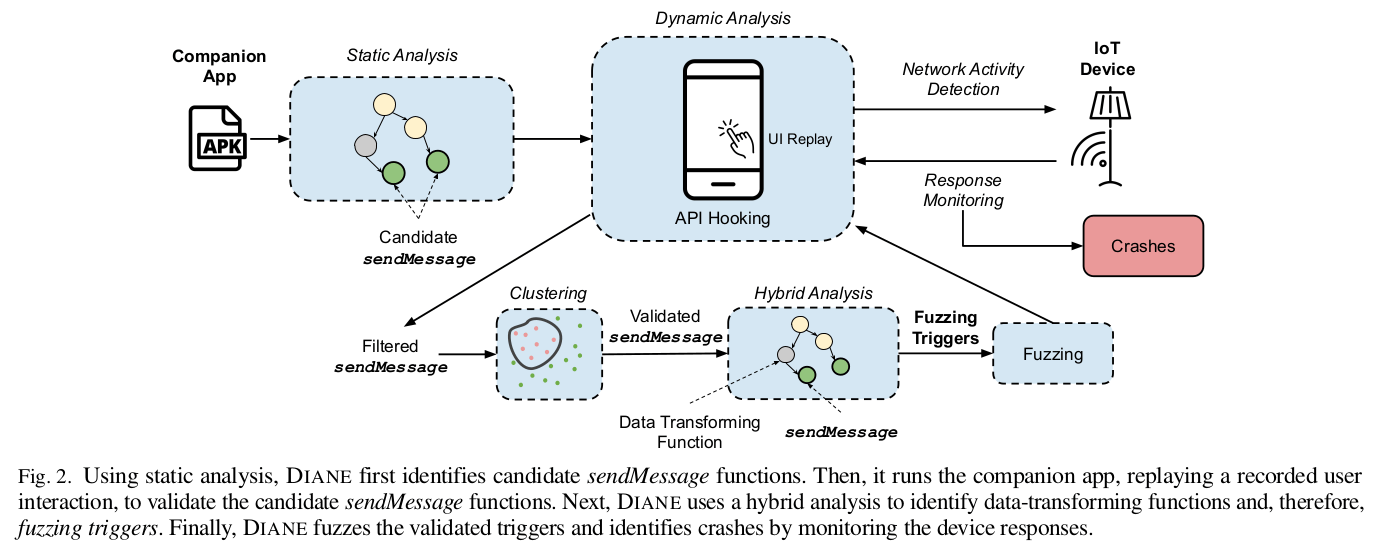
Karonte: Detecting Insecure Multi-binary Interactions in Embedded Firmware
Authors: Nilo Redini, Aravind Machiry, Ruoyu Wang, Chad Spensky, Andrea Continella, Yan Shoshitaishvili, Christopher Kruegel, Giovanni Vigna
Year: 2020
Abstract:
Low-power, single-purpose embedded devices (e.g., routers and IoT devices) have become ubiquitous. While they automate and simplify many aspects of users’ lives, recent large-scale attacks have shown that their sheer number poses a severe threat to the Internet infrastructure. Unfortunately, the software on these systems is hardware-dependent, and typically executes in unique, minimal environments with non-standard configurations, making security analysis particularly challenging. Many of the existing devices implement their functionality through the use of multiple binaries. This multi-binary service implementation renders current static and dynamic analysis techniques either ineffective or inefficient, as they are unable to identify and adequately model the communication between the various executables. In this paper, we present Karonte, a static analysis approach capable of analyzing embedded-device firmware by modeling and tracking multi-binary interactions. Our approach propagates taint information between binaries to detect insecure interactions and identify vulnerabilities. We first evaluated Karonte on 53 firmware samples from various vendors, showing that our prototype tool can successfully track and constrain multi-binary interactions. This led to the discovery of 46 zero-day bugs. Then, we performed a large-scale experiment on 899 different samples, showing that Karonte scales well with firmware samples of different size and complexity.
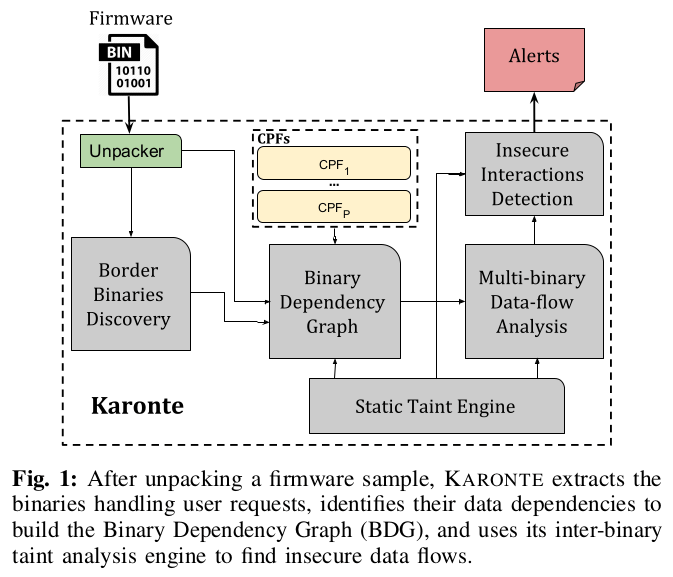
ACM Conference on Computer and Communications Security (6)
MetaEmu: An Architecture Agnostic Rehosting Framework for Automotive Firmware
Authors: Zitai Chen, Sam L. Thomas, Flavio D. Garcia
Year: 2022
Abstract:
In this paper we present MetaEmu, an architecture-agnostic framework geared towards rehosting and security analysis of automotive firmware. MetaEmu improves over existing rehosting environments in two ways: Firstly, it solves the hitherto open-problem of a lack of generic Virtual Execution Environments (VXEs) by synthesizing processor simulators from Ghidra’s language definitions. Secondly, MetaEmu can rehost and analyze multiple targets, each of different architecture, simultaneously, and share analysis facts between each target’s analysis environment, a technique we call inter-device analysis.
We show that the flexibility afforded by our approach does not lead to a performance trade-off—MetaEmu lifts rehosted firmware to an optimized intermediate representation, and provides performance comparable to existing emulation tools, such as Unicorn. Our evaluation spans five different architectures, bare-metal and RTOS-based firmware, and three kinds of automotive Electronic Control Unit (ECU) from four distinct vendors—none of which can be rehosted or emulated by current tools, due to lack of processor support. Further, we show how MetaEmu enables a diverse set of analyses by implementing a fuzzer, a symbolic executor for solving peripheral access checks, a CAN ID reverse engineering tool, and an inter-device coverage tracker.

-
Authors: Wei Zhou, Lan Zhang, Le Guan, Peng Liu, Yuqing Zhang
Year: 2022
Abstract:
Emulating firmware of microcontrollers is challenging due to the lack of peripheral models. Existing work finds out how to respond to peripheral read operations by analyzing the target firmware. This is problematic because the firmware sometimes does not contain enough clues to support the emulation or even contains misleading information (e.g., a buggy firmware). In this work, we propose a new approach that builds peripheral models from the peripheral specification. Using NLP, we translate peripheral behaviors in human language (documented in chip manuals) into a set of structured condition-action rules. By checking, executing, and chaining them at run time, we can dynamically synthesize a peripheral model for each firmware execution. The extracted condition-action rules might not be complete or even be wrong. We, therefore, propose incorporating symbolic execution to quickly pinpoint the root cause. This assists us in the manual correction of the problematic rules. We have implemented our idea for five popular MCU boards spanning three different chip vendors. Using a new edit-distance-based algorithm to calculate trace differences, our evaluation against a large firmware corpus confirmed that our prototype achieves much higher fidelity compared with state-of-the-art solutions. Benefiting from the accurate emulation, our emulator effectively avoids false positives observed in existing fuzzing work. We also designed a new dynamic analysis method to perform driver code compliance checks against the specification. We found some non-compliance which we later confirmed to be bugs caused by race conditions.
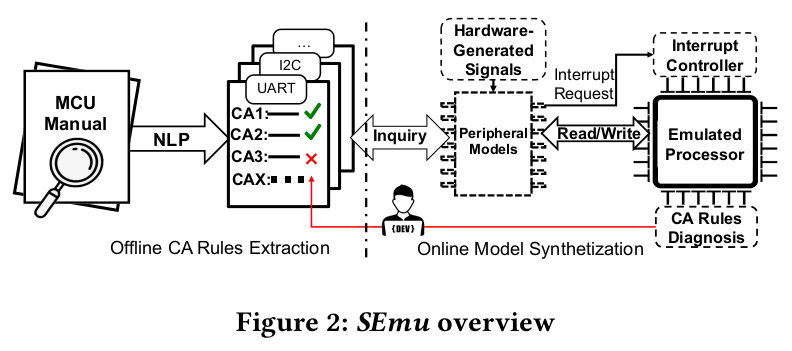
SFuzz: Slice-based Fuzzing for Real-Time Operating Systems
Authors: Libo Chen, Quanpu Cai, Zhenbang Ma, Yanhao Wang, Hong Hu, Minghang Shen, Yue Liu, Shanqing Guo, Haixin Duan, Kaida Jiang, Zhi Xue
Year: 2022
Abstract:
Real-Time Operating System (RTOS) has become the main category of embedded systems. It is widely used to support tasks requiring real-time response such as printers and switches. The security of RTOS has been long overlooked as it was running in special environments isolated from attackers. However, with the rapid development of IoT devices, tremendous RTOS devices are connected to the public network. Due to the lack of security mechanisms, these devices are extremely vulnerable to a wide spectrum of attacks. Even worse, the monolithic design of RTOS combines various tasks and services into a single binary, which hinders the current program testing and analysis techniques working on RTOS. In this paper, we propose SFuzz, a novel slice-based fuzzer, to detect security vulnerabilities in RTOS. Our insight is that RTOS usually divides a complicated binary into many separated but single-minded tasks. Each task accomplishes a particular event in a deterministic way and its control flow is usually straightforward and independent. Therefore, we identify such code from the monolithic RTOS binary and synthesize a slice for effective testing. Specifically, SFuzz first identifies functions that handle user input, constructs call graphs that start from callers of these functions, and leverages forward slicing to build the execution tree based on the call graphs and pruning the paths independent of external inputs. Then, it detects and handles roadblocks within the coarse-grain scope that hinder effective fuzzing, such as instructions unrelated to the user input. And then, it conducts coverage-guided fuzzing on these code snippets. Finally, SFuzz leverages forward and backward slicing to track and verify each path constraint and determine whether a bug discovered in the fuzzer is a real vulnerability. SFuzz successfully discovered 77 zero-day bugs on 35 RTOS samples, and 67 of them have been assigned CVE or CNVD IDs. Our empirical evaluation shows that SFuzz outperforms the state-of-the-art tools (e.g., UnicornAFL) on testing RTOS.

Snipuzz: Black-box Fuzzing of IoT Firmware via Message Snippet Inference
Authors: Xiaotao Feng, Ruoxi Sun, Xiaogang Zhu, Minhui Xue, Sheng Wen, Dongxi Liu, Surya Nepal, Yang Xiang
Year: 2021
Abstract:
The proliferation of Internet of Things (IoT) devices has made people’s lives more convenient, but it has also raised many security concerns. Due to the difficulty of obtaining and emulating IoT firmware, in the absence of internal execution information, black-box fuzzing of IoT devices has become a viable option. However, existing black-box fuzzers cannot form effective mutation optimization mechanisms to guide their testing processes, mainly due to the lack of feedback. In addition, because of the prevalent use of various and non-standard communication message formats in IoT devices, it is difficult or even impossible to apply existing grammar-based fuzzing strategies. Therefore, an efficient fuzzing approach with syntax inference is required in the IoT fuzzing domain.
To address these critical problems, we propose a novel automatic black-box fuzzing for IoT firmware, termed Snipuzz. Snipuzz runs as a client communicating with the devices and infers message snippets for mutation based on the responses. Each snippet refers to a block of consecutive bytes that reflect the approximate code coverage in fuzzing. This mutation strategy based on message snippets considerably narrows down the search space to change the probing messages. We compared Snipuzz with four state-of-the-art IoT fuzzing approaches, i.e., IoTFuzzer, BooFuzz, Doona, and Nemesys. Snipuzz not only inherits the advantages of app-based fuzzing (e.g., IoTFuzzer), but also utilizes communication responses to perform efficient mutation. Furthermore, Snipuzz is lightweight as its execution does not rely on any prerequisite operations, such as reverse engineering of apps. We also evaluated Snipuzz on 20 popular real-world IoT devices. Our results show that Snipuzz could identify 5 zero-day vulnerabilities, and 3 of them could be exposed only by Snipuzz. All the newly discovered vulnerabilities have been confirmed by their vendors.

FirmXRay: Detecting Bluetooth Link Layer Vulnerabilities From Bare-Metal Firmware
Authors: Haohuang Wen, Zhiqiang Lin, Yinqian Zhang
Year: 2020
Abstract:
Today, Bluetooth 4.0, also known as Bluetooth Low Energy (BLE), has been widely used in many IoT devices (e.g., smart locks, smart sensors, and wearables). However, BLE devices could contain a number of vulnerabilities at the BLE link layer during broadcasting, pairing, and message transmission. To detect these vulnerabilities directly from the bare-metal firmware, we present FirmXRay, the first static binary analysis tool with a set of enabling techniques including a novel base address identification algorithm for robust firmware disassembling, precise data structure recognition, and configuration value resolution. As a proof-of-concept, we focus on the BLE firmware from two leading SoC vendors (i.e., Nordic and Texas Instruments), and implement a prototype of FirmXRay atop Ghidra. We have evaluated FirmXRay with 793 unique firmware (corresponding to 538 unique devices) collected using a mobile app based approach, and our experiment results show that 98.1% of the devices have configured random static MAC addresses, 71.5% Just Works pairing, and 98.5% insecure key exchanges. With these vulnerabilities, we demonstrate identity tracking, spoofing, and eavesdropping attacks on real-world BLE devices.
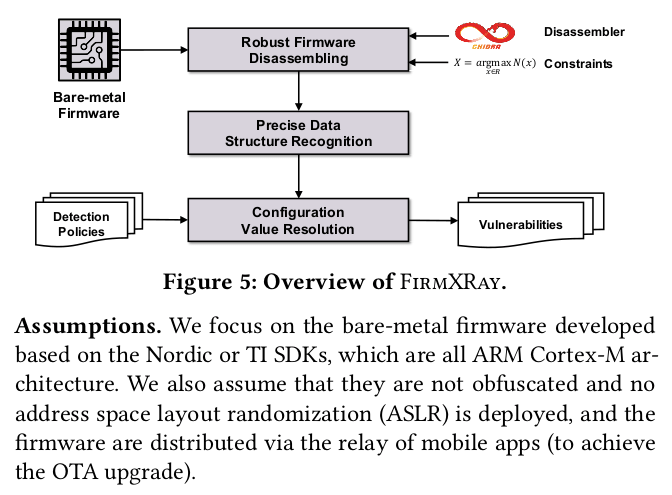
Poster: Fuzzing IoT Firmware via Multi-stage Message Generation
Authors: Bo Yu, Pengfei Wang, Tai Yue, Yong Tang
Year: 2019
Abstract:
In this work, we present IoTHunter, the first grey-box fuzzer for fuzzing stateful protocols in IoT firmware. IoTHunter addresses the state scheduling problem based on a multi-stage message generation mechanism on runtime monitoring of IoT firmware. We evaluate IoTHunter with a set of real-world programs, and the result shows that IoTHunter outperforms black-box fuzzer boofuzz, which has a 2.2x, 2.0x, and 2.5x increase for function coverage, block coverage, and edge coverage, respectively. IoTHunter also found five new vulnerabilities in the firmware of home router Mikrotik, which have been reported to the vendor.

International Conference on Software Engineering (2)
μAFL: Non-intrusive Feedback-driven Fuzzing for Microcontroller Firmware
Authors: Wenqiang Li, Jiameng Shi, Fengjun Li, Jingqiang Lin, Wei Wang, Le Guan
Year: 2022
Abstract:
Fuzzing is one of the most effective approaches to finding software flaws. However, applying it to microcontroller firmware incurs many challenges. For example, rehosting-based solutions cannot accurately model peripheral behaviors and thus cannot be used to fuzz the corresponding driver code. In this work, we present μAFL, a hardware-in-the-loop approach to fuzzing microcontroller firmware. It leverages debugging tools in existing embedded system development to construct an AFL-compatible fuzzing framework. Specifically, we use the debug dongle to bridge the fuzzing environment on the PC and the target firmware on the microcontroller device. To collect code coverage information without costly code instrumentation, μAFL relies on the ARM ETM hardware debugging feature, which transparently collects the instruction trace and streams the results to the PC. However, the raw ETM data is obscure and needs enormous computing resources to recover the actual instruction flow. We therefore propose an alternative representation of code coverage, which retains the same path sensitivity as the original AFL algorithm, but can directly work on the raw ETM data without matching them with disassembled instructions. To further reduce the workload, we use the DWT hardware feature to selectively collect runtime information of interest. We evaluated μAFL on two real evaluation boards from two major vendors: NXP and STMicroelectronics. With our prototype, we discovered ten zero-day bugs in the driver code shipped with the SDK of STMicroelectronics and three zero-day bugs in the SDK of NXP. Eight CVEs have been allocated for them. Considering the wide adoption of vendor SDKs in real products, our results are alarming.
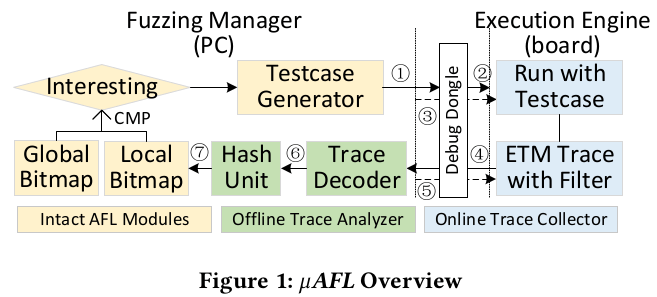
Large-scale Security Measurements on the Android Firmware Ecosystem
Authors: Qinsheng Hou, Wenrui Diao, Yanhao Wang, Xiaofeng Liu, Song Liu, Lingyun Ying, Shanqing Guo, Yuanzhi Li, Meining Nie, Haixin Duan
Year: 2022
Abstract:
Android is the most popular smartphone platform with over 85% market share. Its success is built on openness, and phone vendors can utilize the Android source code to make products with unique software/hardware features. On the other hand, the fragmentation and customization of Android also bring many security risks that have attracted the attention of researchers. Many efforts were put in to investigate the security of customized Android firmware. However, most of the previous work focuses on designing efficient analysis tools or analyzing particular aspects of the firmware. There still lacks a panoramic view of Android firmware ecosystem security and the corresponding understandings based on large-scale firmware datasets. In this work, we made a large-scale comprehensive measurement of the Android firmware ecosystem security. Our study is based on 6,261 firmware images from 153 vendors and 602 Android-related CVEs, which is the largest Android firmware dataset ever used for security measurements. In particular, our study followed a series of research questions, covering vulnerabilities, patches, security updates, and pre-installed apps. To automate the analysis process, we designed a framework, AndScanner, to complete ROM crawling, ROM parsing, patch analysis, and app analysis. Through massive data analysis and case explorations, several interesting findings are obtained. For example, the patch delay and missing issues are widespread in Android images, say 24.2% and 6.1% of all images, respectively. The latest images of several phones still contain vulnerable pre-installed apps, and even the corresponding vulnerabilities have been publicly disclosed. In addition to data measurements, we also explore the causes behind these security threats through case studies and demonstrate that the discovered security threats can be converted into exploitable vulnerabilities via 38 newfound vulnerabilities by our framework, 32 of which have been assigned CVE/CNVD numbers. This study provides much new knowledge of the Android firmware ecosystem with deep understanding of software engineering security practices.

International Conference on Automated Software Engineering (1)
IFIZZ: Deep-State and Efficient Fault-Scenario Generation to Test IoT Firmware
Authors: Peiyu Liu, Shouling Ji, Xuhong Zhang, Qinming Dai, Kangjie Lu, Lirong Fu, Wenzhi Chen, Peng Cheng, Wenhai Wang, Raheem Beyah
Year: 2021
Abstract:
IoT devices are abnormally prone to diverse errors due to harsh environments and limited computational capabilities. As a result, correct error handling is critical in IoT. Implementing correct error handling is non-trivial, thus requiring extensive testing such as fuzzing. However, existing fuzzing cannot effectively test IoT error-handling code. First, errors typically represent corner cases, thus are hard to trigger. Second, testing error-handling code would frequently crash the execution, which prevents fuzzing from testing following deep error paths.
In this paper, we propose IFIZZ, a new bug detection system specifically designed for testing error-handling code in Linux-based IoT firmware. IFIZZ first employs an automated binary-based approach to identify realistic runtime errors by analyzing errors and error conditions in closed-source IoT firmware. Then, IFIZZ employs state-aware and bounded error generation to reach deep error paths effectively. We implement and evaluate IFIZZ on 10 popular IoT firmware. The results show that IFIZZ can find many bugs hidden in deep error paths. Specifically, IFIZZ finds 109 critical bugs, 63 of which are even in widely used IoT libraries. IFIZZ also features high code coverage and efficiency, and covers 67.3% more error paths than normal execution. Meanwhile, the depth of error handling covered by IFIZZ is 7.3 times deeper than that covered by the state-of-the-art method. Furthermore, IFIZZ has been practically adopted and deployed in a worldwide leading IoT company. We will open-source IFIZZ to facilitate further research in this area.

International Symposium on Software Testing and Analysis (1)
-
Authors: Binbin Zhao, Shouling Ji, Jiacheng Xu, Yuan Tian, Qiuyang Wei, Qinying Wang, Chenyang Lyu, Xuhong Zhang, Changting Lin, Jingzheng Wu, Raheem Beyah
Year: 2022
Abstract:
As the core of IoT devices, firmware is undoubtedly vital. Currently, the development of IoT firmware heavily depends on third-party components (TPCs), which significantly improves the development efficiency and reduces the cost. Nevertheless, TPCs are not secure, and the vulnerabilities in TPCs will turn back influence the security of IoT firmware. Currently, existing works pay less attention to the vulnerabilities caused by TPCs, and we still lack a comprehensive understanding of the security impact of TPC vulnerability against firmware. To fill in the knowledge gap, we design and implement FirmSec, which leverages syntactical features and control-flow graph features to detect the TPCs at version-level in firmware, and then recognizes the corresponding vulnerabilities. Based on FirmSec, we present the first large-scale analysis of the usage of TPCs and the corresponding vulnerabilities in firmware. More specifically, we perform an analysis on 34,136 firmware images, including 11,086 publicly accessible firmware images, and 23,050 private firmware images from TSmart. We successfully detect 584 TPCs and identify 128,757 vulnerabilities caused by 429 CVEs. Our in-depth analysis reveals the diversity of security issues for different kinds of firmware from various vendors, and discovers some well-known vulnerabilities are still deeply rooted in many firmware images. We also find that the TPCs used in firmware have fallen behind by five years on average. Besides, we explore the geographical distribution of vulnerable devices, and confirm the security situation of devices in several regions, e.g., South Korea and China, is more severe than in other regions. Further analysis shows 2,478 commercial firmware images have potentially violated GPL/AGPL licensing terms.
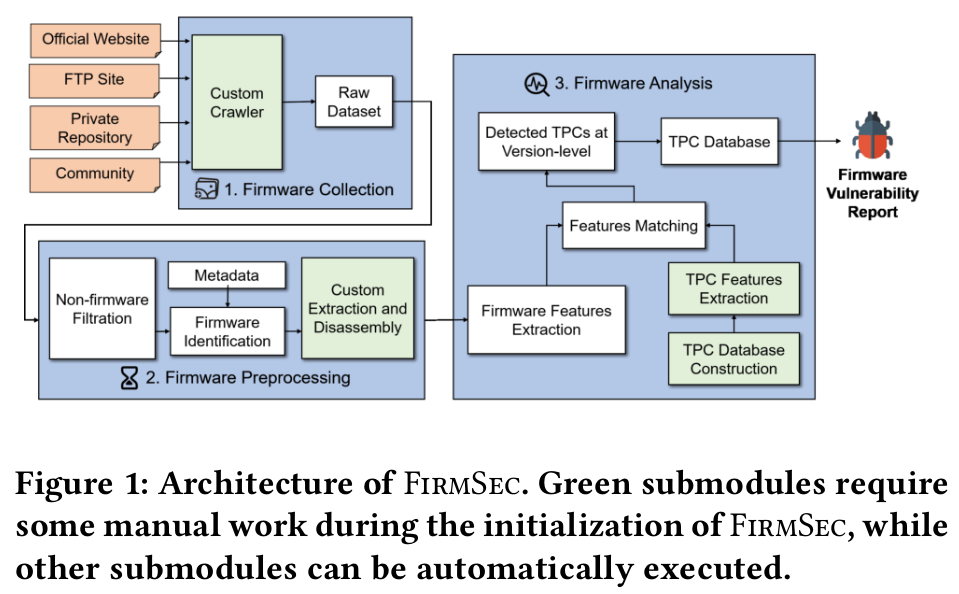
Design Automation Conference (1)
UEFI Firmware Fuzzing with Simics Virtual Platform
Authors: Zhenkun Yang, Yuriy Viktorov, Jin Yang, Jiewen Yao, Vincent Zimmer
Year: 2020
Abstract:
This paper presents a fuzzing framework for Unified Extensible Firmware Interface (UEFI) BIOS with the Simics virtual platform. Firmware has increasingly become an attack target as operating systems are getting more and more secure. Due to its special execution environment and the extensive interaction with hardware, UEFI firmware is difficult to test compared to user-level applications running on operating systems. Fortunately, virtual platforms are widely used to enable early software and firmware development by modeling the target hardware platform in its virtual environment before silicon arrives. Virtual platforms play a critical role in left shifting UEFI firmware validation to pre-silicon phase. We integrated the fuzzing capability into Simics virtual platform to allow users to fuzz UEFI firmware code with high-fidelity hardware models provided by Simics. We demonstrated the ability to automatically detect previously unknown bugs, and issues found only by human experts.
